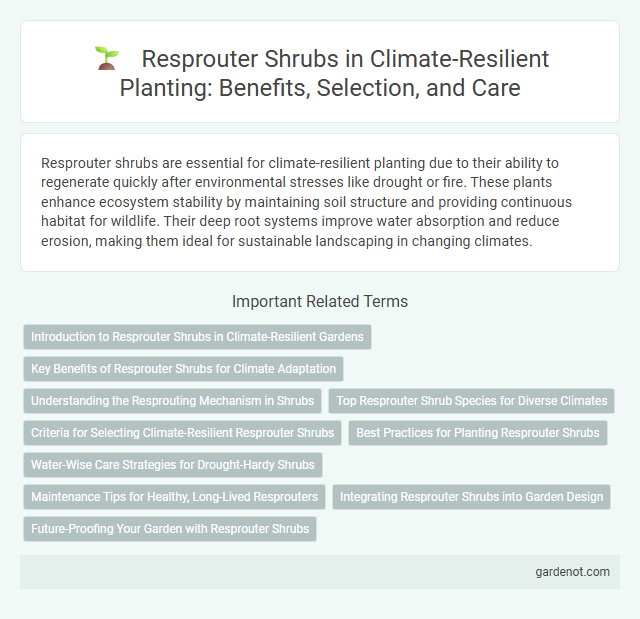Resprouter shrubs are essential for climate-resilient planting due to their ability to regenerate quickly after environmental stresses like drought or fire. These plants enhance ecosystem stability by maintaining soil structure and providing continuous habitat for wildlife. Their deep root systems improve water absorption and reduce erosion, making them ideal for sustainable landscaping in changing climates.
Introduction to Resprouter Shrubs in Climate-Resilient Gardens
Resprouter shrubs possess a remarkable ability to regenerate from their root systems after disturbances such as fire or drought, making them ideal for climate-resilient gardens. Their deep-rooted structures enhance soil stability and water retention, contributing to ecosystem recovery and long-term sustainability. These shrubs improve landscape resilience by withstanding extreme weather conditions and promoting biodiversity in changing climates.
Key Benefits of Resprouter Shrubs for Climate Adaptation
Resprouter shrubs enhance climate adaptation by quickly regenerating after disturbances such as fires, floods, or droughts, ensuring vegetation cover and soil stability. Their deep root systems improve water retention and nutrient cycling, contributing to ecosystem resilience under changing climate conditions. These shrubs support biodiversity by providing continuous habitat and food resources despite environmental stresses.
Understanding the Resprouting Mechanism in Shrubs
Resprouter shrubs possess specialized lignotubers and dormant buds that enable vigorous shoot regeneration following environmental disturbances such as fire, drought, or mechanical damage. This resprouting mechanism facilitates rapid recovery by mobilizing stored carbohydrates and activating meristematic tissues, ensuring survival and maintaining ecosystem stability. Understanding these physiological and genetic adaptations enhances the development of climate-resilient planting strategies in restoration ecology.
Top Resprouter Shrub Species for Diverse Climates
Top resprouter shrub species for diverse climates include manzanita (Arctostaphylos spp.), ceanothus (Ceanothus spp.), and chamise (Adenostoma fasciculatum), all known for their ability to regenerate after fire and drought. These species exhibit deep root systems and adaptive growth patterns that enhance soil stabilization and promote ecosystem resilience in arid, Mediterranean, and wildfire-prone regions. Their drought tolerance and rapid resprouting capacity make them ideal choices for climate-resilient planting strategies aimed at maintaining biodiversity and reducing erosion under changing environmental conditions.
Criteria for Selecting Climate-Resilient Resprouter Shrubs
Selecting climate-resilient resprouter shrubs involves prioritizing species with strong regenerative capacity after disturbances such as drought, fire, or extreme weather events. Key criteria include deep root systems for water access, inherent tolerance to temperature fluctuations, and rapid resprouting ability from lignotubers or root crowns. These traits ensure long-term survival and ecosystem stability under changing climate conditions.
Best Practices for Planting Resprouter Shrubs
Plant resprouter shrubs in well-drained soils with adequate organic matter to enhance root regeneration after disturbances. Space plants to ensure sufficient air circulation, reducing disease risk and promoting robust growth. Employ mulch layers to maintain soil moisture and temperature stability, supporting vigorous resprouting capacity in changing climatic conditions.
Water-Wise Care Strategies for Drought-Hardy Shrubs
Resprouter shrubs possess deep root systems that enable efficient water uptake, making them ideal for drought-prone environments. Implementing mulching techniques around these plants reduces soil evaporation, preserving critical moisture levels to support their resilience. Strategic watering during early morning hours further enhances water absorption while minimizing waste, optimizing the growth of drought-hardy resprouter shrubs.
Maintenance Tips for Healthy, Long-Lived Resprouters
Resprouter shrubs thrive with minimal watering once established, requiring well-drained soil and occasional mulching to retain moisture and suppress weeds. Pruning dead or damaged branches after fires or storms stimulates vigorous regrowth and maintains plant health. Regularly monitoring for pests and diseases ensures early intervention, promoting the longevity and resilience of resprouter shrubs in climate-stressed environments.
Integrating Resprouter Shrubs into Garden Design
Incorporating resprouter shrubs into garden design enhances climate resilience by enabling plants to regenerate quickly after drought or fire events, ensuring sustained greenery and biodiversity. These shrubs, such as manzanita or ceanothus, possess deep root systems that improve soil stability and water retention, crucial for drought-prone landscapes. Strategic placement of resprouters provides natural firebreaks and supports ecosystem recovery, making them essential for sustainable, resilient garden ecosystems.
Future-Proofing Your Garden with Resprouter Shrubs
Resprouter shrubs enhance climate resilience by regenerating quickly after fires, droughts, or extreme weather events, ensuring long-term garden stability. Their deep root systems improve soil retention and water absorption, reducing erosion and maintaining ecosystem health. Incorporating resprouter shrubs into garden designs future-proofs landscapes against shifting climate patterns and increasing environmental stressors.
Resprouter shrub Infographic

 gardenot.com
gardenot.com